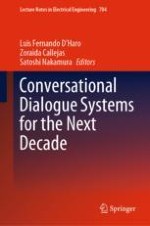2021 | OriginalPaper | Chapter
Packing, Stacking, and Tracking: An Empirical Study of Online User Adaptation
Authors : Jean-Sébastien Laperrière, Darryl Lam, Kotaro Funakoshi
Published in: Conversational Dialogue Systems for the Next Decade
Publisher: Springer Singapore
Activate our intelligent search to find suitable subject content or patents.
Select sections of text to find matching patents with Artificial Intelligence. powered by
Select sections of text to find additional relevant content using AI-assisted search. powered by
